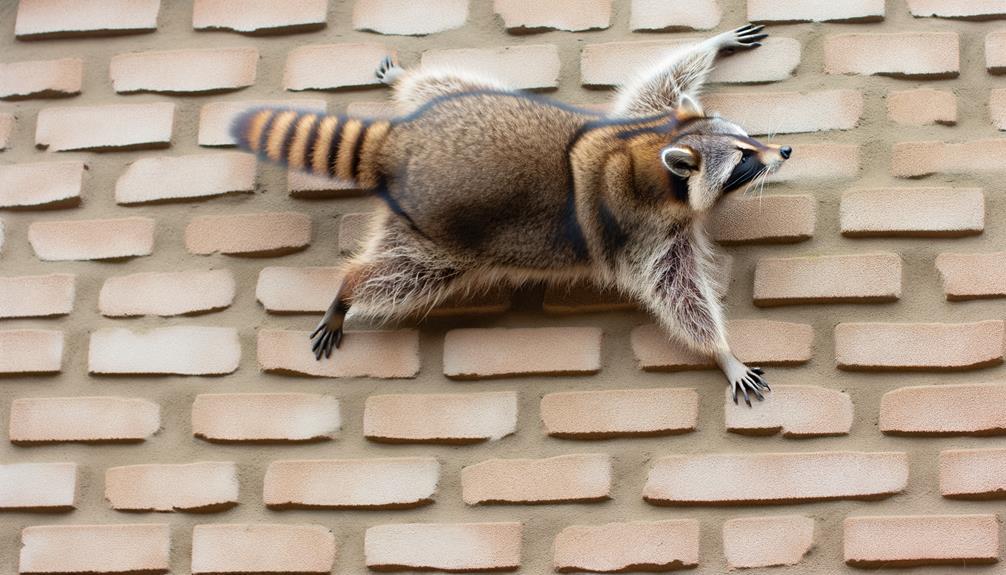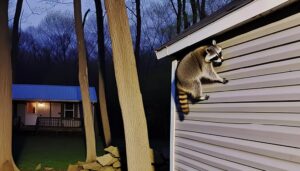How Raccoons Climb Up the Side of Your House: A Step-by-Step Guide
Raccoons are adept climbers, utilizing their specialized anatomy to scale vertical surfaces, including house exteriors. Their robust limbs, dexterous forepaws, and semi-retractable claws provide excellent grip and maneuverability.
They can climb inclines over 90 degrees and leverage structural weaknesses such as damaged shingles and unscreened vents to gain access. Urban environments offer ample food and shelter, contributing to their infiltration of human habitats.
Raccoons employ their dynamic body positioning and tactile-sensitive pads for traction on varying wall textures. Maintaining secure roofs and gardens, coupled with humane deterrents, can minimize raccoon intrusion.
For in-depth insight into their climbing techniques and preventive measures, continue exploring.

Key Takeaways
- Raccoons possess specialized climbing anatomy, enabling them to scale vertical surfaces, including house exteriors.
- Their semi-retractable claws and robust limbs provide the necessary grip and strength to climb house walls.
- Dexterous forepaws and tactile-sensitive pads enhance their ability to navigate different textures and surfaces.
- High rotational freedom in their forelimbs allows raccoons to adjust body positioning dynamically while climbing.
- They can exploit structural weaknesses like gaps, cracks, and damaged shingles to gain access to homes.
Raccoon's Climbing Anatomy

Raccoons possess a highly specialized climbing anatomy, characterized by their robust limbs, dexterous forepaws, and semi-retractable claws, which enable them to scale vertical surfaces with remarkable agility. Their forelimbs exhibit a high degree of rotational freedom, facilitating precise manipulation and grip.
The hind limbs provide substantial support and propulsion. Semi-retractable claws contribute to their adeptness, anchoring securely into various substrates, including wood, brick, and metal. Observational studies indicate that raccoons can ascend structures with inclines exceeding 90 degrees.
Their tactile-sensitive pads enhance grip and balance, essential for negotiating vertical environments. Anatomical adaptations, such as elongated metacarpal bones and powerful flexor muscles, further optimize their climbing efficiency. Collectively, these features underscore the raccoon's exceptional climbing capabilities.
Typical Urban Habitats
Urban habitats provide an array of resources and structures that are conducive to raccoon habitation and activity. These environments offer ample food sources, shelter, and opportunities for exploration. Observations indicate that raccoons are adept at exploiting various urban features, such as garbage bins, attics, and sewer systems. Their adaptability is evidenced by their increasing population in metropolitan areas.
Common Urban Structures | Raccoon Activity | Emotional Response
————————-|——————|——————
Garbage Bins | Foraging | Frustration
Attics | Nesting | Concern
Sewer Systems | Travel Routes | Intrigue
Gardens | Searching for Food| Delight
This table succinctly illustrates how raccoons interact with typical urban structures, evoking a range of emotions from residents. Understanding these interactions is vital for managing cohabitation with these nocturnal mammals.
Vertical Surface Techniques

Raccoons possess extraordinary claws and grip strength, which are crucial in their ability to scale vertical surfaces. The texture of walls, whether smooth or rough, greatly influences their climbing efficacy.
Additionally, raccoons exhibit specialized climbing techniques, such as alternating limb coordination and balance adjustments, enabling them to navigate various architectural structures.
Claws and Grip Strength
The robust claws of Procyon lotor, coupled with their significant grip strength, enable these mammals to scale vertical surfaces with astonishing proficiency. Each claw is sharply curved, providing an anchoring mechanism that allows raccoons to latch onto minute crevices and irregularities.
Studies have demonstrated that their forelimbs exhibit remarkable dexterity and strength, facilitating upward propulsion. The musculature in their limbs is adapted for powerful, coordinated movements, which is critical for maintaining balance and support on vertical planes.
In addition, raccoons possess hyper-mobile ankle joints that can rotate 180 degrees, enhancing their climbing capabilities. This anatomical adaptation permits them to descend headfirst with control, an essential skill for maneuvering the complex structures they often encounter in urban environments.
Wall Texture Impact
Surface texture has a profound impact on the climbing efficacy of Procyon lotor, determining the level of traction and stability these mammals can achieve on vertical structures.
Smooth, non-porous surfaces such as metal or glass impede their climbing capabilities due to reduced grip. Conversely, rough or porous textures, including brick, stucco, and wood, offer abundant footholds and tactile feedback, facilitating more effective climbing.
Empirical observations and studies confirm that raccoons exhibit a noticeable preference for textured surfaces, which optimize friction and minimize the risk of slippage. This behavior underscores the critical role of wall texture in enabling these animals to navigate anthropogenic environments with ease, highlighting a key factor in their adaptive urban success.
Climbing Technique Adaptations
Leveraging the advantageous properties of textured surfaces, Procyon lotor employs specialized climbing techniques, enabling effective ascension of vertical structures. Anatomically, raccoons possess highly dexterous forelimbs with semi-retractable claws, which facilitate a strong grip on irregular surfaces. Their hind limbs, endowed with considerable strength, provide propulsion and stability during vertical climbs.
Empirical observations indicate that raccoons utilize a combination of gripping, pulling, and pushing motions to navigate vertical walls. Additionally, their acute sense of balance and spatial awareness allows them to adjust their body positioning dynamically. Field studies have documented raccoons climbing various substrates, including brick, wood, and stucco, demonstrating remarkable adaptability.
This repertoire of climbing adaptations underscores their proficiency in overcoming architectural barriers for accessing food and shelter.
Common Entry Points
Raccoons demonstrate a remarkable ability to exploit structural weaknesses in buildings, leading to frequent intrusions through various entry points. Especially, roof and attic access, chimneys, and vents, and gaps and cracks are primary avenues utilized by these adept climbers.
Detailed studies and observations have confirmed their proficiency in finding such entry points, often driven by the search for shelter and food.
Roof and Attic Access
While evaluating common entry points for raccoons, it is critical to recognize that roof and attic access often occurs through damaged shingles, unscreened vents, and unattended chimneys. These areas present vulnerabilities that raccoons exploit due to their dexterous forepaws and climbing prowess.
Research indicates raccoons possess the capacity to scale vertical surfaces, enabling them to reach high points on buildings. Observations reveal that once on the roof, raccoons can easily tear through compromised roofing materials, gaining entry into attic spaces.
Additionally, raccoons are known to leverage structural weaknesses, such as gaps in soffits or fascia boards, to infiltrate homes. Preventative measures, including regular roof inspections and prompt repairs, are essential in mitigating these risks and ensuring home integrity.
Chimneys and Vents
Chimneys and vents serve as common entry points for raccoons, often due to the absence or degradation of protective barriers such as chimney caps and vent covers. Raccoons are adept climbers, capable of scaling vertical surfaces to access these openings. Once inside, they may cause structural damage or create nests, posing both safety and health risks.
Field observations and studies have identified several factors contributing to this issue:
- Degraded Chimney Caps: Worn-out or missing caps allow raccoons easy access.
- Unprotected Vents: Vents without covers provide straightforward entry points.
- Structural Vulnerabilities: Poorly maintained structures offer more opportunities for entry.
Understanding these entry points is critical for implementing effective exclusion methods and maintaining the integrity of residential properties.
Gaps and Cracks
In addition to chimneys and vents, structural gaps and cracks in buildings present significant entry points for raccoons, worsening the challenges of wildlife intrusion. Raccoons are skilled climbers and can exploit even the smallest openings, often found near roofing, eaves, and foundations. Empirical observations indicate that raccoons can squeeze through gaps as small as 3 inches in diameter.
These entry points are frequently overlooked during routine inspections, allowing raccoons to gain access to attics, basements, and wall voids. The presence of raccoons within these spaces can lead to structural damage, insulation contamination, and potential health hazards due to fecal matter and parasites.
Regular maintenance and prompt sealing of identified gaps and cracks are essential in mitigating raccoon intrusion.
Seasonal Behavior Patterns

Raccoons exhibit distinct seasonal behavior patterns that are mainly influenced by changes in temperature and food availability. During the colder months, raccoons often enter a state of torpor, reducing their activity levels to conserve energy.
In contrast, warmer seasons see an increase in their foraging activities as they exploit abundant food sources. Additionally, breeding behaviors are typically observed in late winter to early spring, coinciding with the preparation of dens for offspring.
- Winter: Reduced activity, increased torpor, and reliance on cached food.
- Spring: Heightened foraging, breeding, and den establishment.
- Summer/Fall: Intensive foraging to build fat reserves for winter.
These patterns underscore the raccoon's adaptability to seasonal variations, significantly impacting their interaction with human habitats.
Signs of Raccoon Presence
Evidence of raccoon presence can be identified through a combination of physical signs and behavioral indicators.
Physical signs include tracks with a distinct five-toed pattern and claw marks on vertical surfaces, indicating climbing activity. Homeowners may also find scat, typically cylindrical with undigested food remains.
Behavioral indicators encompass nocturnal noises, such as scratching or thumping, often heard from attics or walls. Raccoons may also leave evidence of foraging behavior, such as overturned garbage cans or disrupted garden beds.
Additionally, grease stains around entry points, caused by the raccoon's fur, and nesting materials like leaves or insulation in secluded areas, further confirm their presence.
Recognizing these signs is essential for timely intervention and mitigation.
Preventive Measures

To mitigate the risk of raccoons climbing the side of a house, it is essential to secure food sources, block roof access, and install motion-activated lights.
Scientific studies indicate that raccoons are opportunistic feeders, so ensuring that garbage bins are tightly sealed can notably reduce attraction.
Additionally, physical barriers such as metal flashing and strategic lighting have been shown to deter these nocturnal animals from accessing rooftops.
Secure Food Sources
Ensuring that all food sources are securely stored and inaccessible is vital in preventing raccoons from attempting to climb the side of a house in search of sustenance. The attraction to easily accessible food can drive raccoons to extraordinary lengths, including scaling vertical surfaces. Research indicates that minimizing attractants plays an important role in wildlife management.
Homeowners should implement the following measures:
- Secure trash cans: Utilize bins with locking mechanisms to prevent raccoons from accessing refuse.
- Store pet food indoors: Avoid leaving pet food outside, especially overnight, as it can attract nocturnal foragers.
- Clean up fallen fruit: Regularly remove any fallen fruits or nuts from your yard, which can serve as an easy food source.
These strategies are essential for mitigating raccoon-related disturbances.
Block Roof Access
Minimizing attractants is only part of the solution; homeowners must also implement measures to physically block raccoons' access to roofs. Effective strategies include installing metal flashing around potential entry points such as vents, chimneys, and eaves. Metal flashing, typically made of galvanized steel or aluminum, creates a slippery surface that raccoons cannot grip.
Additionally, trimming tree branches and removing climbing aids like trellises and latticework can further restrict access. Empirical evidence supports the efficacy of these barriers; studies demonstrate a significant reduction in roof intrusions when such measures are implemented.
Moreover, securing garbage bins and ensuring that pet food is not left outside can diminish the likelihood of raccoons attempting to scale the house in search of sustenance.
Install Motion Lights
Installing motion-activated lights around the perimeter of a home can serve as a formidable deterrent against raccoon intrusions. Lighting systems, triggered by movement, can startle and discourage these nocturnal creatures, reducing their propensity to climb and explore residential structures.
Empirical evidence suggests that abrupt illumination can disrupt raccoon behavior patterns, causing them to seek refuge elsewhere.
Key advantages include:
- Enhanced Surveillance: Provides clear visibility of nocturnal activities around the property.
- Behavioral Disruption: Sudden light startles raccoons, leading to avoidance behavior.
- Energy Efficiency: Modern motion-activated lights are designed to be power-efficient, activating only when necessary.
Incorporating motion lights is a scientifically supported, practical measure to mitigate the risk of raccoon-related property damage.
Chimney Safeguards
To prevent raccoons from accessing your home through the chimney, it is vital to implement strong chimney safeguards such as stainless steel chimney caps and mesh screens. Stainless steel chimney caps are particularly effective due to their durability and resistance to rust, ensuring long-term protection.
Mesh screens, with openings no larger than 0.5 inches, are essential in preventing raccoons from squeezing through. Studies have shown that raccoons are skilled climbers and can exploit even small vulnerabilities in chimney structures. As such, a combination of high-quality materials and precise installation is critical.
Regular inspections and maintenance of these safeguards can mitigate the risk of raccoon intrusions, providing an evidence-based approach to wildlife management and home security.
Roof and Attic Security

Given raccoons' adept climbing abilities, securing the roof and attic is paramount to prevent these animals from gaining entry into higher levels of the home. Evidence suggests that raccoons can exploit even minimal vulnerabilities. As a result, homeowners should prioritize the following measures:
- Attic Vent Reinforcement: Utilize heavy-duty mesh to cover vents, deterring raccoons from using these openings as entry points.
- Roof Inspection: Regularly inspect and repair shingles and fascia boards, ensuring no gaps or damaged areas that raccoons can leverage.
- Soffit and Eave Security: Install sturdy soffit and eave guards to fortify these susceptible areas against intrusion.
Scientific observations corroborate the efficacy of these measures in mitigating unwanted raccoon access, enhancing the overall security of the home.
Garden and Yard Protection
Protecting gardens and yards from raccoon intrusions requires an evidence-based approach, leveraging physical barriers and strategic deterrents to mitigate potential damage. Studies indicate that raccoons are highly adept at climbing various structures and finding their way through common garden barriers.
As a result, installing robust fencing, preferably electrified or with a buried base, can effectively reduce access. Additionally, securing compost bins, trash cans, and pet food sources is critical, as these attractants are primary motivators for raccoon activity.
Motion-activated lights and sprinklers have also shown efficacy in startling and deterring these nocturnal creatures. Empirical evidence suggests that a multifaceted strategy combining these elements can greatly lower the incidence of raccoon-related garden damage, promoting a secure and thriving outdoor environment.
Humane Deterrents

Implementing humane deterrents against raccoons involves utilizing methods such as auditory and olfactory repellents, which leverage the animals' sensory perceptions to discourage their presence without causing harm. These strategies are grounded in scientific principles and aim to create an environment that raccoons find unappealing.
Effective deterrents include:
- Auditory Repellents: High-frequency sounds that are inaudible to humans but disturbing to raccoons.
- Olfactory Repellents: Substances like ammonia or predator urine which exploit raccoons' acute sense of smell.
- Visual and Physical Barriers: Motion-activated lights and sturdy fencing to startle and obstruct raccoons.
Empirical studies have shown that combining these methods enhances efficacy, reducing raccoon activity significantly in residential areas.
Professional Help Options
Engaging professional wildlife control services can provide a thorough and scientifically informed approach to managing raccoon intrusions. These experts use a combination of exclusion techniques and habitat modification strategies, based on a deep understanding of raccoon behavior and ecology.
Detailed inspections are carried out to identify entry points and attractants, followed by the implementation of exclusion devices such as one-way doors and heavy-gauge mesh. Evidence-based practices guarantee humane treatment, in line with wildlife conservation principles.
Professionals also offer long-term solutions, suggesting modifications to landscaping and structural repairs to prevent future access. This systematic, evidence-driven approach not only ensures the immediate removal of raccoons but also reduces the risk of recurrence, protecting both property and wildlife.
Conclusion
The juxtaposition of raccoons' adept climbing anatomy with urban environments highlights their ability to exploit vertical surfaces for entry. Evidence-based observations reveal common entry points such as attics and roofs, especially during specific seasonal behaviors.
Implementing security measures for roofs and attics, alongside garden and yard protection, helps reduce these risks. Humane deterrents offer additional safeguards. For persistent issues, professional intervention remains a wise option.
Therefore, the intersection of biological capability and urban challenges requires thorough prevention strategies.






